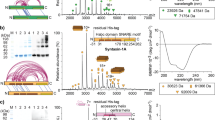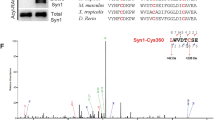Abstract
A neuron forms thousands of presynaptic nerve terminals on its axons, far removed from the cell body. The protein CSPα resides in presynaptic terminals, where it forms a chaperone complex with Hsc70 and SGT. Deletion of CSPα results in massive neurodegeneration that impairs survival in mice and flies. In CSPα-knockout mice, levels of presynaptic SNARE complexes and the SNARE protein SNAP-25 are reduced, suggesting that CSPα may chaperone SNARE proteins, which catalyse synaptic vesicle fusion. Here, we show that the CSPα–Hsc70–SGT complex binds directly to monomeric SNAP-25 to prevent its aggregation, enabling SNARE-complex formation. Deletion of CSPα produces an abnormal SNAP-25 conformer that inhibits SNARE-complex formation, and is subject to ubiquitylation and proteasomal degradation. Even in wild-type mouse terminals, SNAP-25 degradation is regulated by synaptic activity; this degradation is decreased by CSPα overexpression, and enhanced by CSPα deletion. Thus, SNAP-25 function is maintained during rapid SNARE cycles by equilibrium between CSPα-dependent chaperoning and ubiquitin-dependent degradation, revealing unique protein quality-control machinery within the presynaptic compartment.
This is a preview of subscription content, access via your institution
Access options
Subscribe to this journal
Receive 12 print issues and online access
$209.00 per year
only $17.42 per issue
Buy this article
- Purchase on Springer Link
- Instant access to full article PDF
Prices may be subject to local taxes which are calculated during checkout







Similar content being viewed by others
Change history
21 December 2010
In the version of this article initially published online and in print, grant information was missing from the acknowledgements.
References
Katz, B. The Release of Neuronal Transmitter Substances (Liverpool University Press, 1969).
Wickner, W. & Schekman, R. Membrane fusion. Nat. Struct. Mol. Biol. 15, 658–664 (2008).
Sudhof, T. C. & Rothman, J. E. Membrane fusion: grappling with SNARE and SM proteins. Science 323, 474–477 (2009).
Sollner, T., Bennett, M. K., Whiteheart, S. W., Scheller, R. H. & Rothman, J. E. A protein assembly-disassembly pathway in vitro that may correspond to sequential steps of synaptic vesicle docking, activation and fusion. Cell 75, 409–418 (1993).
Sutton, R. B., Fasshauer, D., Jahn, R. & Brunger, A. T. Crystal structure of a SNARE complex involved in synaptic exocytosis at 2.4 A resolution. Nature 395, 347–353 (1998).
Kushmerick, C., Renden, R. & von Gersdorff, H. Physiological temperatures reduce the rate of vesicle pool depletion and short-term depression via an acceleration of vesicle recruitment. J. Neurosci. 26, 1366–1377 (2006).
Matsuda, W. et al. Single nigrostriatal dopaminergic neurons form widely spread and highly dense axonal arborizations in the neostriatum. J. Neurosci. 29, 444–453 (2009).
Hartl, F. U. & Hayer-Hartl, M. Molecular chaperones in the cytosol: from nascent chain to folded protein. Science 295, 1852–1858 (2002).
Arvan, P., Zhao, X., Ramos-Castaneda, J. & Chang, A. Secretory pathway quality control operating in Golgi, plasmalemmal, and endosomal systems. Traffic 3, 771–780 (2002).
Anelli, T. & Sitia, R. Protein quality control in the early secretory pathway. EMBO J. 27, 315–327 (2008).
Burré, J. et al. α-synuclein promotes SNARE-complex assembly in vivo and in vitro. Science 329, 1663–1667 (2010).
Buchner, E. & Gundersen, C. B. The DnaJ-like cysteine string protein and exocytotic neurotransmitter release. Trends Neurosci. 20, 223–227 (1997).
Chamberlain, L. H. & Burgoyne, R. D. Cysteine-string protein: the chaperone at the synapse. J. Neurochem. 74, 1781–1789 (2000).
Young, J. C., Agashe, V. R., Siegers, K. & Hartl, F. U. Pathways of chaperone-mediated protein folding in the cytosol. Nat. Rev. Mol. Cell Biol. 5, 781–791 (2004).
Johnson, J. N., Ahrendt, E. & Braun, J. E. CSPα: the neuroprotective J protein. Biochem. Cell Biol. 88, 157–165 (2010).
Chamberlain, L. H. & Burgoyne, R. D. The molecular chaperone function of the secretory vesicle cysteine string proteins. J. Biol. Chem. 272, 31420–31426 (1997).
Tobaben, S. et al. A trimeric protein complex functions as a synaptic chaperone machine. Neuron 31, 987–999 (2001).
Fernandez-Chacon, R. et al. The synaptic vesicle protein CSPα prevents presynaptic degeneration. Neuron 42, 237–251 (2004).
Umbach, J. A. et al. Presynaptic dysfunction in Drosophila csp mutants. Neuron 13, 899–907 (1994).
Zinsmaier, K. E., Eberle, K. K., Buchner, E., Walter, N. & Benzer, S. Paralysis and early death in cysteine string protein mutants of Drosophila. Science 263, 977–980 (1994).
Ruiz, R., Casanas, J. J., Sudhof, T. C. & Tabares, L. Cysteine string protein-α is essential for the high calcium sensitivity of exocytosis in a vertebrate synapse. Eur. J. Neurosci. 27, 3118–3131 (2008).
Schmitz, F. et al. CSPα-deficiency causes massive and rapid photoreceptor degeneration. Proc. Natl Acad. Sci. USA 103, 2926–2931 (2006).
Chandra, S., Gallardo, G., Fernandez-Chacon, R., Schluter, O. M. & Sudhof, T. C. α-synuclein cooperates with CSPα in preventing neurodegeneration. Cell 123, 383–396 (2005).
Gundersen, C. B., Mastrogiacomo, A., Faull, K. & Umbach, J. A. Extensive lipidation of a Torpedo cysteine string protein. J. Biol. Chem. 269, 19197–19199 (1994).
Chamberlain, L. H. & Burgoyne, R. D. Cysteine string protein functions directly in regulated exocytosis. Mol. Biol. Cell 9, 2259–2267 (1998).
Palleros, D. R., Reid, K. L., Shi, L., Welch, W. J. & Fink, A. L. ATP-induced protein-Hsp70 complex dissociation requires K+ but not ATP hydrolysis. Nature 365, 664–666 (1993).
Flynn, G. C., Chappell, T. G. & Rothman, J. E. Peptide binding and release by proteins implicated as catalysts of protein assembly. Science 245, 385–390 (1989).
Jahn, R. & Scheller, R. H. SNAREs—engines for membrane fusion. Nat. Rev. Mol. Cell Biol. 7, 631–643 (2006).
Sollner, T. et al. SNAP receptors implicated in vesicle targeting and fusion. Nature 362, 318–324 (1993).
Jahn, R. & Südhof, T. C. Synaptic vesicle traffic: rush hour in the nerve terminal. J. Neurochem. 61, 12–21 (1993).
Zhang, H. et al. Cysteine string protein interacts with and modulates the maturation of the cystic fibrosis transmembrane conductance regulator. J. Biol. Chem. 277, 28948–28958 (2002).
Garcia-Junco-Clemente, P. et al. Cysteine string protein-α prevents activity-dependent degeneration in GABAergic synapses. J. Neurosci. 30, 7377–7391 (2010).
Mattson, M. P. Excitotoxic and excitoprotective mechanisms: abundant targets for the prevention and treatment of neurodegenerative disorders. Neuromolecular Med. 3, 65–94 (2003).
Mabb, A. M. & Ehlers, M. D. Ubiquitination in postsynaptic function and plasticity. Annu. Rev. Cell Dev. Biol. 26, 179–210 (2010).
Segref, A. & Hoppe, T. Think locally: control of ubiquitin-dependent protein degradation in neurons. EMBO Rep. 10, 44–50 (2009).
Okiyoneda, T. et al. Peripheral protein quality control removes unfolded CFTR from the plasma membrane. Science 329, 805–810 (2010).
Pang, Z. P., Cao, P., Xu, W. & Sudhof, T. C. Calmodulin controls synaptic strength via presynaptic activation of calmodulin kinase II. J. Neurosci. 30, 4132–4142 (2010).
Chomczynski, P. A reagent for the single-step simultaneous isolation of RNA, DNA and proteins from cell and tissue samples. Biotechniques 15, 532–534, 536–537 (1993).
Maximov, A., Pang, Z. P., Tervo, D. G. & Sudhof, T. C. Monitoring synaptic transmission in primary neuronal cultures using local extracellular stimulation. J. Neurosci. Methods 161, 75–87 (2007).
Xu, J., Mashimo, T. & Sudhof, T. C. Synaptotagmin-1, -2, and -9: Ca(2+) sensors for fast release that specify distinct presynaptic properties in subsets of neurons. Neuron 54, 567–581 (2007).
Ho, A., Liu, X. & Sudhof, T. C. Deletion of Mint proteins decreases amyloid production in transgenic mouse models of Alzheimer's disease. J. Neurosci. 28, 14392–14400 (2008).
Sharma, M., Benharouga, M., Hu, W. & Lukacs, G. L. Conformational and temperature-sensitive stability defects of the ΔF508 cystic fibrosis transmembrane conductance regulator in post-endoplasmic reticulum compartments. J. Biol. Chem. 276, 8942–8950 (2001).
Hayashi, T. et al. Synaptic vesicle membrane fusion complex: action of clostridial neurotoxins on assembly. EMBO J. 13, 5051–5061 (1994).
Sugita, S. & Sudhof, T. C. Specificity of Ca2+-dependent protein interactions mediated by the C2A domains of synaptotagmins. Biochemistry 39, 2940–2949 (2000).
Tang, J. et al. A complexin/synaptotagmin 1 switch controls fast synaptic vesicle exocytosis. Cell 126, 1175–1187 (2006).
Rosahl, T. W. et al. Essential functions of synapsins I and II in synaptic vesicle regulation. Nature 375, 488–493 (1995).
Acknowledgements
We thank S. Chandra for discussions, and J. Mitchell, A. Roth and I. Kornblum for technical support. This work was supported by the National Institute on Aging (NIH grant RC2AG036614 to T.C.S.), and fellowships from the Human Frontiers Program (LT00527/2006-L to M.S.) and the 'Deutsche Akademie der Naturforscher Leopoldina' (BMBF-LPD 9901/8-161 to J.B.).
Author information
Authors and Affiliations
Contributions
M.S. and T.C.S. designed the study. M.S. and J.B. performed and analysed the experiments. M.S., J.B. and T.C.S. wrote the manuscript.
Corresponding authors
Ethics declarations
Competing interests
The authors declare no competing financial interests.
Supplementary information
Supplementary Information
Supplementary Information (PDF 1130 kb)
Rights and permissions
About this article
Cite this article
Sharma, M., Burré, J. & Südhof, T. CSPα promotes SNARE-complex assembly by chaperoning SNAP-25 during synaptic activity. Nat Cell Biol 13, 30–39 (2011). https://doi.org/10.1038/ncb2131
Received:
Accepted:
Published:
Issue Date:
DOI: https://doi.org/10.1038/ncb2131
This article is cited by
-
Tissue distribution of cysteine string protein/DNAJC5 in C. elegans analysed by CRISPR/Cas9-mediated tagging of endogenous DNJ-14
Cell and Tissue Research (2024)
-
L116 Deletion in CSPα Promotes α-Synuclein Aggregation and Neurodegeneration
Molecular Neurobiology (2024)
-
Neuronal-specific TNFAIP1 ablation attenuates postoperative cognitive dysfunction via targeting SNAP25 for K48-linked ubiquitination
Cell Communication and Signaling (2023)
-
C3N nanodots inhibits Aβ peptides aggregation pathogenic path in Alzheimer’s disease
Nature Communications (2023)
-
Synaptic tau: A pathological or physiological phenomenon?
Acta Neuropathologica Communications (2021)



